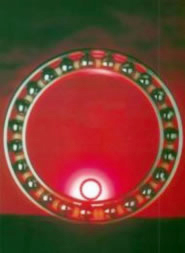| |
|
| Thin Section Bearings |
There are three types of thin-section bearings: deep groove bearings, four-point contact bearings, and angular contact bearings. Compared with standard-section ball bearings all three bearing types offer advantages in reduced space requirements and low cost. These bearings are used primarily where shaft location is the major requirement.
As structural components these thin-section bearings behave differently to standard bearings because their bearing rings are quite flexible. |
 |
Under load the rings follow the imperfections of shaft and bores, consequently, it is essential that these components be geometrically accurate.
The four-point contact bearings support thrust loads in either direction these are much more effective in resisting moment loads than the deep-groove design bearings.
Two other bearing designs use an axial split in the outer ring to increase ball complement and radial capacity without sacrificing thrust capacity. One is a full-complement design, the other uses alternating full-size balls and spacer balls. The latter type also has high shoulders on the outer ring to provide integral shields for grease lubrication. Both types of bearings are held together with wire bands after assembly.
LYC thin-section bearings are used widely in Aircraft, Aerospace, Textile printer, Medical devices, Radar Communication, Astronomy instrumentation and Industrial robotics etc. because their characteristics such as small space, light weight and low friction. |
|
|
